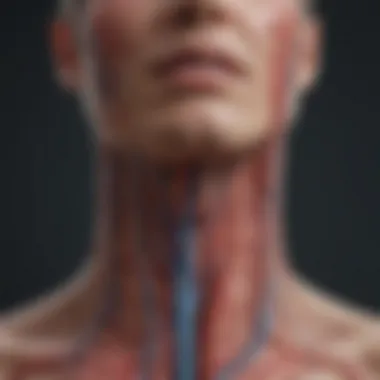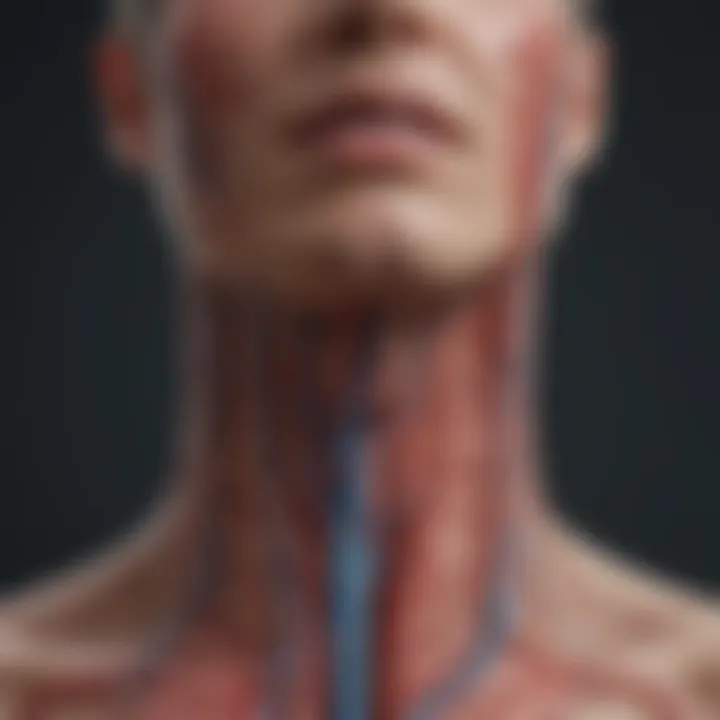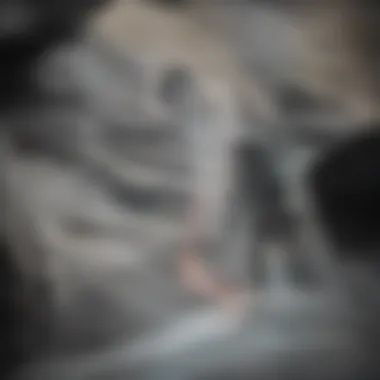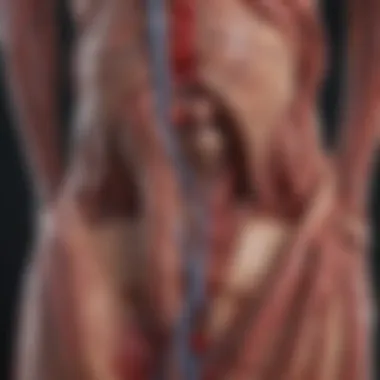Understanding the Vascular Sheath: A Comprehensive Examination


Intro
The vascular sheath is a complex structure that plays a crucial role in the human body. Understanding its anatomy and functionality is important for a wide range of professionals, including medical students, researchers, and clinicians. This article seeks to shed light on the intricate details of the vascular sheath, outlining its significance within both physiological and pathological contexts. As we delve into this topic, we will explore its contributions to overall health while also considering its implications in various diseases.
Key Findings
Major Results
Through meticulous examination, we have uncovered several key insights regarding the vascular sheath. Its primary function is to provide protection for blood vessels and nerves. The vascular sheath, composed of connective tissue, encapsulates these vital structures, preventing damage from external forces. Additionally, it plays a role in the compartmentalization of different vascular elements, which aids in the regulation of blood flow and nerve signaling.
Moreover, the vascular sheath is involved in inflammatory responses. When injury occurs, the sheath can either promote healing or contribute to pathological inflammation, depending on the circumstances. Thus, understanding this balance is essential for effective clinical management.
Discussion of Findings
The research has implications beyond mere anatomy. A thorough comprehension of the vascular sheath can enhance diagnostic approaches in cases of vascular diseases. For instance, abnormalities in the sheath may signify underlying conditions such as atherosclerosis or thrombosis. Clinical assessments that incorporate knowledge of the vascular sheath can yield insights into disease progression and inform treatment strategies.
Methodology
Research Design
This examination is grounded in a comprehensive review of existing literature. By synthesizing findings from various studies, we aim to construct a cohesive understanding of the vascular sheath.
Data Collection Methods
Data were collected from academic journals, clinical studies, and anatomical texts. Information was gathered through systematic literature reviews and meta-analyses, ensuring a robust collection of relevant details. Furthermore, collaborative insights from professionals in vascular biology and clinical medicine were integrated to broaden the scope of this discussion.
"The vascular sheath acts as more than a mere covering; it is a dynamic entity that influences vascular health significantly."
Closure
Prologue to the Vascular Sheath
The vascular sheath is a critical anatomical structure that warrants thorough examination due to its multifaceted roles in the human body. It functions primarily as a protective layer for blood vessels and nerves, playing a vital part in maintaining circulatory dynamics and overall tissue health. The examination of the vascular sheath touches on various fields of study, making it relevant for students and professional practitioners alike. Understanding these fundamental aspects can lead to better insights into both normal physiological processes and pathological conditions.
Definition and Overview
The vascular sheath is essentially a connective tissue capsule surrounding blood vessels and nerves. This structure not only provides support but also offers insulation from surrounding tissues. It facilitates components such as the arterial and venous networks, which are essential for transporting blood throughout the body. Different organs exhibit variations in the vascular sheath's composition, which reflects the specific requirements of the vascular system within those regions. Understanding these differences can provide insight into how the vascular system adapts to the functional needs of various tissues.
Historical Perspectives
The concept of the vascular sheath is not entirely new. Historically, scholars and medical professionals have noted its presence and significance. Studies dating back to the early anatomical observations have illustrated that an understanding of the vascular sheath can lead to a better grasp of circulatory systems. Ancient anatomists like Galen emphasized the importance of surrounding tissues, although the term 'vascular sheath' as we know it today emerged much later. Over time, advancements in histology and imaging techniques have allowed for deeper investigations, revealing the complexities and critical roles of the vascular sheath in both health and disease. Such historical insights are essential today as they set the stage for current research and applications in clinical contexts.
Anatomy of the Vascular Sheath
The anatomy of the vascular sheath is critical to understanding its overall function in human physiology. This section will focus on the specific elements of the vascular sheath, considering how its structure supports its various roles within the body. Understanding its anatomy allows for a deeper appreciation of how it protects blood vessels and facilitates blood flow.
Location and Structure
The vascular sheath typically encases major blood vessels, providing support while maintaining their integrity. It is often found in close proximity to nerves and surrounding tissues. The relationship between blood vessels and their sheaths is important because it allows for efficient blood flow without causing damage to the vessels themselves. The structure of the sheath is composed of different tissue types, which together perform the essential functions necessary for vascular health.
Components of the Sheath


The vascular sheath is made up of three primary components: epithelial tissue, connective tissue, and muscle tissue.
Epithelial Tissue
Epithelial tissue is a crucial component of the vascular sheath. It acts as a protective barrier, preventing external substances from entering the bloodstream. This tissue is characterized by its closely packed cells, which provide a seamless interface between the blood vessel and surrounding environment. Epithelial tissue’s unique feature is its ability to allow selective permeability, which is essential for maintaining homeostasis. The benefits of epithelial tissue in this context include its regenerative capabilities, allowing for quick recovery from damage. However, an excessive inflammatory response can compromise its function.
Connective Tissue
Connective tissue provides structural support to the vascular sheath. It surrounds the blood vessels, ensuring that they remain securely in place. This type of tissue is rich in fibers, which contribute to its strength and elasticity. One key characteristic of connective tissue is its role in providing a medium for the exchange of nutrients and waste between blood and surrounding cells. Connective tissue includes various types such as loose connective tissue and dense connective tissue, both of which serve vital functions. The unique feature of connective tissue is its ability to adapt in response to different physiological demands. However, changes in the composition or integrity of this tissue can lead to vascular dysfunction.
Muscle Tissue
Muscle tissue is essential for the dynamic function of the vascular sheath. Smooth muscle cells within the sheath help regulate the diameter of blood vessels. This regulation is vital for maintaining proper blood pressure and flow. The key characteristic of muscle tissue is its contractility, allowing it to respond to physiological stimuli, such as neural signals or hormonal changes. The beneficial aspect of muscle tissue in this context is its ability to constrict or expand blood vessels as needed. A potential disadvantage is that prolonged contraction can lead to vascular issues, such as hypertension.
Variations Across Different Organs
The anatomy of the vascular sheath may vary significantly across different organs. These variations can influence the overall function and importance of the sheath in each specific context. For example, in organs requiring higher blood flow, the shear might have different structural adaptations compared to those in organs with lower metabolic demands. Understanding these variations is crucial for recognizing how the vascular sheath contributes to organ-specific functions and overall health.
Functions of the Vascular Sheath
The vascular sheath is essential in maintaining both structural integrity and functional efficiency in the circulatory system. By providing protection and support, facilitating blood flow, and contributing to innervation and sensory functions, this sheath plays a significant role in the overall health of vascular systems. Understanding these functions is crucial not only for medical professionals but also for students and researchers focused on cardiovascular health and disease management.
Protection and Support
The primary function of the vascular sheath is to protect and support surrounding structures. This sheath forms a barrier around blood vessels and nerves, preventing external damage from physical impacts or external factors. The dense connective tissue within the sheath contributes to its strength and resilience, which is vital in high-pressure environments such as arteries. Furthermore, the vascular sheath supports the architecture of blood vessels, ensuring they maintain their shape during various physiological activities.
The protection offered by the vascular sheath is paramount during surgical procedures. Surgeons must navigate this sheath to access the blood vessels and nerves underneath while minimizing potential damage. Additionally, when trauma occurs, the vascular sheath can reduce the risk of complications by preventing blood vessel rupture and controlling bleedings around the injury site.
Facilitation of Blood Flow
Another critical function of the vascular sheath involves the facilitation of blood flow. By encasing arteries, veins, and capillaries, the sheath helps to maintain optimal blood pressure and blood flow dynamics. It serves not only as a conduit for vessels but also as a means of regulating blood flow through vascular modulation. This is essential for delivering nutrients and removing waste products from tissues efficiently.
Vascular compliance, which is the ability of blood vessels to expand and contract, is influenced by the vascular sheath. A well-formed sheath can enhance compliance, enabling vessels to adapt to varying blood volumes and flow rates. When the sheath functions properly, it minimizes turbulence and aids in the smooth flow of blood, which is crucial for maintaining accurate oxygen and nutrient delivery to tissues.
Innervation and Sensory Function
The vascular sheath also plays a role in innervation and sensory functions. It is not merely a passive structure, as it contains nerve fibers that can transmit signals affecting vascular tone. These signals can come from both internal and external sources, influencing blood vessel dilation and constriction. Thus, the vascular sheath is involved in regulating blood flow based on physiological needs, including during exercise or in response to temperature changes.
Furthermore, sensory receptors within the sheath can detect changes in pressure and chemical composition of blood, allowing for real-time feedback to the central nervous system. This plays a role in homeostasis, ensuring that the body's responses are tailored to varying conditions, effectively maintaining balance.
The functions of the vascular sheath, from protection to facilitating blood flow and sensory input, highlight its essential role in the human circulatory system. Understanding these dynamics is critical for addressing various health challenges and improving treatment methodologies.
In summary, the vascular sheath is a multi-functional component that goes beyond mere structural support. Its roles in protecting blood vessels, facilitating optimal blood flow, and providing sensory feedback are crucial. Ongoing research further uncovers the complexities of the vascular sheath, emphasizing its importance in medical knowledge and practice.
The Vascular Sheath in Health
The vascular sheath plays a vital role in maintaining the health of the human body. It serves as a protective barrier and a supportive structure for blood vessels and nerves. Understanding its functions helps in recognizing how integral it is to circulatory health and the overall well-being of organs. The vascular sheath helps to keep the vascular system stable and functioning properly. Each aspect of its role complements the body’s physiological processes. This section will discuss three main areas: its role in circulatory health, its impact on tissue perfusion, and its interaction with surrounding tissues.
Role in Circulatory Health
The vascular sheath contributes significantly to circulatory health by ensuring that blood vessels are adequately protected from external stressors. It provides physical support that prevents damage to the vessels. In doing so, it helps maintain the integrity of the blood flow. When blood vessels are protected, the risk of vascular diseases decreases. These diseases can lead to serious conditions such as heart attacks and strokes. A well-functioning vascular sheath also aids in the regulation of blood pressure, which is crucial for maintaining an optimal balance in the circulatory system.
"The health of the vascular sheath is directly connected to the well-being of the entire circulatory system."


Impact on Tissue Perfusion
Tissue perfusion is the delivery of blood to tissues. The vascular sheath supports this process by ensuring that blood vessels stay open and efficient in their function. When blood flows freely, organs receive the necessary nutrients and oxygen. Disruption in perfusion can lead to severe complications, as affected tissues may not receive adequate oxygen. The vascular sheath's structural properties help keep blood vessels patent, especially during physical activities when blood flow requirements increase. Enhanced tissue perfusion contributes to better organ function, promotes healing, and overall vitality of the tissues involved.
Interaction with Surrounding Tissues
The vascular sheath does not exist in isolation; rather, it interacts closely with surrounding tissues. This interaction allows for the coordination of physiological processes. For example, it aids in the communication between nerves and blood vessels, facilitating both sensory functions and vasoregulation. The vascular sheath also enables the exchange of signaling molecules between blood vessels and adjacent cells. This communication is critical in responding to injury or inflammation. Therefore, a healthy vascular sheath supports a symbiotic relationship that is key for homeostasis in various systems within the body.
This section elaborates on the significance of the vascular sheath and its multifunctional role in health. Recognizing its contributions can help guide clinical practices and future research aimed at enhancing circulatory health.
Pathological Implications of the Vascular Sheath
The vascular sheath holds significant implications for various pathologies. Understanding these implications helps elucidate the broader physiological context within which vascular sheaths operate. It also emphasizes the relationship between health and disease, providing crucial insights for medical professionals and researchers.
Diseases Affecting the Vascular Sheath
Vascular Inflammation
Vascular Inflammation is an important aspect of the vascular sheath that warrants attention. It often arises from various underlying conditions, such as autoimmune diseases or chronic inflammatory states. A key characteristic of vascular inflammation is the increased permeabilty of vascular walls, which allows immune cells to migrate towards sites of injury or infection. This responsiveness plays a vital role in maintaining homeostasis and protecting tissues during injury.
The prominence of vascular inflamation in this article stems from its dual nature. While it is essential for immune defense, it can also lead to detrimental effects if uncontrolled. Chronic inflammation may contribute to the development of atherosclerosis and other cardiovascular diseases.
A unique feature of vascular inflammation is its signaling pathways. They activate various cells, such as endothelial and smooth muscle cells. Understanding these pathways can offer insights into potential therapeutic avenues. However, excessive vascular inflammation might pose disadvantages, leading to tissue damage and fibrosis.
Vascular Tumors
Vascular tumors also present critical implications for the vascular sheath's integrity. These tumors can be benign or malignant, impacting the surrounding vascular structures. A primary characteristic of vascular tumors is their ability to disrupt normal blood flow and oxygen delivery to tissues. This disruption raises significant concerns regarding tissue viability and function.
Vascular tumors are particularly relevant in discussions about the vascular sheath due to their potential impact on health. Benign tumors might exert pressure on adjacent vessels, while malignant types can invade and destroy vascular tissues. A unique feature of vascular tumors is their varied proliferation rates; some grow slowly while others can metastasize rapidly.
In terms of advantages and disadvantages, vascular tumors can serve as indicators of underlying disease processes, providing diagnostic value. However, the risks associated with malignant degeneration necessitate a thorough understanding of these tumors and their behavior in the vascular sheath context.
Role in Injury and Repair
The vascular sheath plays a significant role in injury and repair processes. Following an injury, the vascular sheath helps orchestrate the healing process, influencing inflammation, tissue regeneration, and remodeling. Understanding this role can aid in the development of novel therapeutic strategies aimed at enhancing recovery after vascular injury.
Research Developments and Findings
Understanding the vascular sheath is essential not only to comprehend its vital roles in human physiology but also to explore its implications in various medical fields. Advancements in research bring about significant revelations that refine our perception and inform future clinical practices. This section will navigate through contemporary methodologies employed in the study of vascular sheath, highlight key experimental outcomes, and suggest prospective research trajectories.
Current Methodologies
Current research related to the vascular sheath often employs a blend of traditional histological techniques and modern imaging methodologies. Histochemistry remains a cornerstone for identifying specific cellular components, allowing researchers to visualize tissue structure in detail. This includes staining techniques that differentiate between various tissue types, such as epithelial and connective tissues. Moreover, molecular biology techniques, including PCR and RNA sequencing, provide insights into gene expression patterns within vascular sheaths. These methodologies are vital in understanding the dynamic nature of the sheath across different states of health and disease.
Researchers are also utilizing advanced imaging techniques such as magnetic resonance imaging (MRI) and computed tomography (CT) to study the vascular sheath's properties non-invasively. These approaches allow for real-time observation of blood flow and tissue changes, crucial for assessing the functional aspects of the vascular sheath in various conditions.
Key Experimental Outcomes
Numerous studies have reported important outcomes related to the vascular sheath's role in health and disease. One significant finding reveals a correlation between vascular sheath integrity and the efficiency of tissue perfusion. In instances of vascular inflammation, the sheath's structure and mechanical properties tend to alter, which has implications for blood flow and nutrient delivery to tissues.
Additionally, experimental data supports the idea that alterations in the vascular sheath are early indicators of certain vascular diseases. For example, changes in the composition of the vascular sheath have been documented in conditions like atherosclerosis, whereby the sheath becomes stiffer or more fibrous, potentially impairing vascular function. These findings underscore the importance of early detection and monitoring of vascular sheath characteristics in clinical settings.


Future Directions in Research
Future research on the vascular sheath is promising, particularly with the integration of technology and interdisciplinary collaboration. One area of interest is the impact of bioengineering on vascular health. Reconstructive surgery and tissue engineering are evolving fields that could leverage insights from vascular sheath studies. Developing biocompatible scaffold materials that mimic the vascular sheath may lead to innovative solutions for repairing or replacing damaged vascular structures.
Furthermore, researchers may explore the implications of genetic variations and their relationship to sheath composition and functionality. Advances in genomics and proteomics can yield valuable data on the molecular mechanisms that govern interactions between the vascular sheath and surrounding tissues, as well as changes during pathological conditions.
"The study of the vascular sheath is a window into understanding systemic health and disease, warranting a closer examination of both its architecture and its function in a broader physiological context."
As we venture into these future studies, collaboration between experts from various fields—such as cardiology, molecular biology, and bioengineering—will be necessary to unlock deeper insights into the vascular sheath's critical functions and potential clinical applications.
Clinical Applications of the Vascular Sheath
The study of the vascular sheath extends beyond anatomy and physiology. It holds significant value in clinical applications that span surgical practices, diagnostic measures, and therapeutic advancements. Understanding these applications is essential for professionals in healthcare as they navigate complex medical scenarios involving vascular systems.
Surgical Considerations
When it comes to surgery, the vascular sheath plays a pivotal role in guiding vascular access and protecting surrounding structures. Surgeons must be aware of the precise anatomy of the vascular sheath to minimize risks during procedures.
- Vascular Access: The vascular sheath is crucial for procedures like central venous catheterization. It serves as a protective barrier, reducing the likelihood of complications such as injury to adjacent arteries or nerves.
- Surgical Dissection: During operations, understanding the layout of the vascular sheath can assist in safer and more effective surgical dissection, particularly in complex areas like the neck or pelvic region.
- Post-operative Care: Knowledge of the vascular sheath aids in anticipating potential complications post-surgery. For instance, knowledge about the sheath's integrity can inform the management of hematomas or vascular leaks.
Overall, meticulous attention to the vascular sheath’s anatomy enhances surgical outcomes and patient safety.
Diagnostic Techniques
Advancements in diagnostic imaging have transformed how clinicians assess the vascular sheath and its associated structures. Various techniques are utilized to provide insights into vascular health.
- Ultrasound Imaging: This non-invasive method is frequently used to visualize the vascular sheath and surrounding tissues. Its real-time imaging capability allows for immediate assessment of blood flow and vascular integrity.
- Magnetic Resonance Imaging (MRI): MRI can offer detailed views of the vascular sheath, assisting in identifying any anatomical abnormalities or pathological conditions.
- Computed Tomography (CT): CT scans provide cross-sectional images, highlighting the relationship between the vascular sheath and adjacent organs.
These diagnostic tools are integral for early detection of vascular conditions, informing treatment plans effectively.
Therapeutic Innovations
Therapeutic methods targeting the vascular sheath have gained traction in clinical settings. Innovations in treatment approaches can lead to enhanced patient outcomes.
- Targeted Drug Delivery: Advanced techniques are being researched to deliver medications more directly to the affected vascular structures within the sheath, increasing efficacy while minimizing systemic side effects.
- Regenerative Medicine: Approaches in regenerative medicine aim to repair or regenerate damaged vascular sheaths. This can involve using stem cells or biomaterials to foster tissue repair.
- Endovascular Techniques: Minimally invasive procedures, such as catheter-based interventions, rely on a thorough understanding of the vascular sheath for maneuverability and treatment efficacy.
With ongoing research, the landscape of therapeutic innovations continues to evolve, promising improved interventions in vascular medicine.
The vascular sheath's role in clinical applications bridges basic science and practical medicine, underscoring its significance in patient care.
The End
In concluding this article, it is imperative to emphasize the essential role of the vascular sheath in both health and disease. The vascular sheath is not merely a structural component but a dynamic entity with various functions that influence the overall body physiology. Understanding its anatomy, roles, and clinical applications unveils a plethora of benefits for medical professionals and researchers.
Recap of Key Concepts
To summarize, the vascular sheath serves several critical functions, including:
- Protection of blood vessels and nerves: It provides a supportive framework that shields vital structures from injury.
- Facilitation of blood flow: The design of the sheath assists in maintaining optimal blood circulation.
- Interaction with surrounding tissues: The sheath plays a role in tissue perfusion and communication with adjacent cells, impacting healing and response mechanisms.
Moreover, the exploration of diseases that affect the vascular sheath such as vascular inflammation and tumors highlights its significance in clinical diagnostics and therapeutic strategies. Through various methodologies and research findings, the vascular sheath’s role continues to be substantiated, indicating a compelling area of study moving forward.
Final Reflections on the Vascular Sheath's Role
Ultimately, the vascular sheath is a focal point in understanding the complexities of human physiology. Its involvement in both healing processes and disease states calls for continued exploration and innovation within the medical field. The insights gained from this examination contribute not only to academic knowledge but also to practical applications in surgery, diagnostics, and therapeutic developments. As research advances, the potential for new therapeutic approaches that target the vascular sheath may emerge, thus enriching the landscape of clinical medicine.
"The vascular sheath is pivotal to the interactions between circulatory health and systemic disease processes. Its comprehensive study is vital for improved clinical outcomes."
In closing, the vascular sheath's intricate roles underscore the importance of ongoing research and education in the realm of vascular biology.



